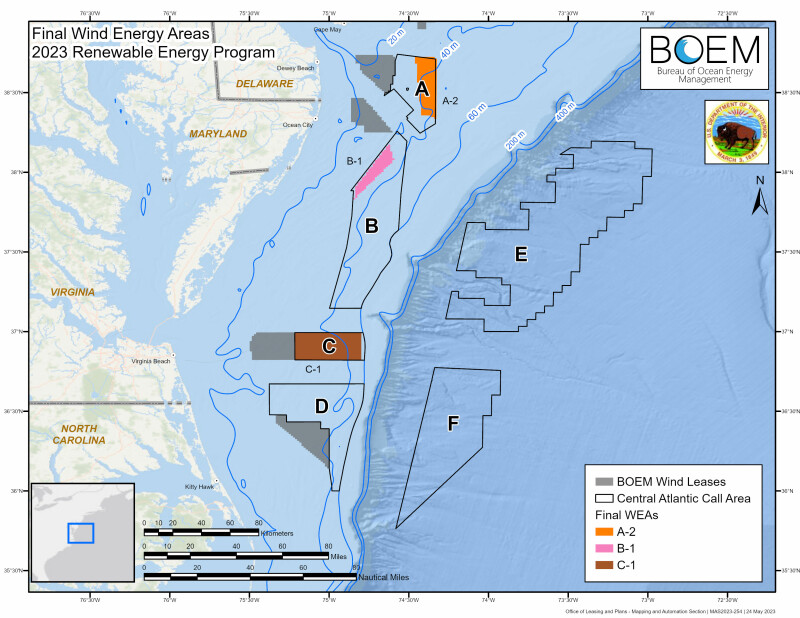Three new offshore wind energy areas off Delaware, Maryland and Virginia were announced Monday by the Bureau of Ocean Energy Management, covering some 557 square miles beginning 23.5 nautical miles off Ocean City, Md.
If developed to full potential, the wind energy areas, or WEAs, could potentially support peak energy outputs between 4 gigawatts and 8 GW, according to BOEM.
The first WEA (A-2) is 101,767 acres and located 26 nautical miles from Delaware Bay. The second WEA (B-1) is 78,285 acres and about 23.5 nm offshore of Ocean City, Md. The third WEA (C-1) is 176,506 acres and located about 35 nm from the mouth of the Chesapeake Bay, off Virginia. Together the areas cover total approximately 356,550 acres.
The agency will publish a notice of intent to prepare an environmental assessment of leasing to wind power developers in the Federal Register on Aug.1. That will kick off a 30-day public comment period.
The proposed WEAs are derived from eight draft wind power areas that BOEM announced Nov. 16, 2022 over 1.7 million acres of federal waters. Those were winnowed out from an initial draft proposal in April 2022 that included some 3.9 million acres.
To get there, BOEM worked with the National Oceanic and Atmospheric Administration’s National Centers for Coastal Ocean Science (NCCOS) to develop “a comprehensive, ecosystem-based ocean planning model that assisted in the selection of the final WEAs,” according to BOEM.
“This model leveraged best available data on natural resources, ocean industries like fisheries and energy production, and areas of national security activities to identify areas with high wind energy resource potential while reducing potential impacts to other ocean users and sensitive environmental resources,” the agency says. “This comprehensive approach not only provided valuable insights about the seascape and uses of the ocean region, but also facilitated greater transparency and positive coordination with government partners and ocean stakeholders through direct engagement and incorporation of their feedback into the NCCOS model.”
The potential for wind power development to affect other maritime industries – particularly shipping and commercial fishing – brought much commentary into BOEM’s planning process.
BOEM is still assessing with the Department of Defense and NASA to determine if building wind turbines on WEA B-1 proposed off the Delmarva coast could be compatible with Navy, Air Force and space program activities, BOEM officials said.
The Navy and Air Force use Mid-Atlantic waters and airspace extensively for operations and training. NASA operates the Wallops Flight Facility near Chincoteague, Va., with launch facilities and associated ranges.
“The results of the final in-depth assessment from DoD and NASA will be used to inform whether WEA B-1 should be included in a possible lease sale, which would be the next step in the wind energy process,” according to the agency. “There would be another public comment period if BOEM decides to move forward with a proposed lease sale, and if Area WEA B-1 is included in a proposed lease sale, any necessary mitigation would be identified to inform bidders in advance of a future sale.”
“BOEM values a robust and transparent offshore wind planning process, which requires early and frequent engagement with Tribal governments, the Department of Defense, NASA, other government agencies, and ocean users” BOEM Director Liz Klein said in announcing the final areas. “We will continue to work closely with them, and all interested stakeholders, as we move forward with our environmental review.”







